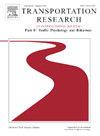Road-crossing behavior and safety of pedestrians facing autonomous vehicles with an acceleration indicator eHMI in VR traffic flow
IF 3.5
2区 工程技术
Q1 PSYCHOLOGY, APPLIED
Transportation Research Part F-Traffic Psychology and Behaviour
Pub Date : 2024-10-04
DOI:10.1016/j.trf.2024.09.023
引用次数: 0
Abstract
To support pedestrian road-crossing behavior in the presence of autonomous vehicles (AVs), we propose a novel external Human-Machine Interface (eHMI) that enhances the vehicle’s inherent motion cues, which pedestrians already use in traditional traffic. Based on the Beta Movement, the eHMI design consists of light bands with multiple arrows moving forward or backward to indicate the vehicle’s accelerating or decelerating motion state. We measured pedestrians’ behavior and perceived safety when faced with AVs equipped with this acceleration indicator eHMI in a virtual reality (VR) street scene, where pedestrians had road-crossing tasks and vehicles did not always yield. We found that pedestrians exhibited crossing behavior according to the motion state of the oncoming vehicle. They almost always crossed if the vehicle yielded but considered the gap size to cross when it did not. With the acceleration indicator eHMI, they crossed more frequently if the vehicle yielded, yet less frequently if it did not. Although risky crossings could not be fully prevented, pedestrians crossed faster and maintained larger safety margins when the non-yielding vehicle used this eHMI. Additionally, pedestrians started to cross earlier when the eHMI indicated the vehicle’s decelerating state. Regarding pedestrians’ perceived safety, the eHMI did not increase perceived safety for decelerating vehicles but effectively decreased the perceived safety for accelerating vehicles. These results demonstrate the potential of enhancing vehicles’ inherent motion cues with eHMIs, but also imply that making vehicles’ motion state more apparent might not simply increase pedestrians’ perceived safety. Overall, a trade-off seems to exist that it is pedestrians’ sense of unsafety that leads to their safe road-crossing behavior. Suggestions for future research and VR experiments were also discussed.
在 VR 交通流中使用加速度指示器 eHMI 面对自动驾驶汽车时行人的过路行为和安全问题
为了支持行人在自动驾驶汽车(AV)面前的过马路行为,我们提出了一种新颖的外部人机接口(eHMI),它可以增强车辆固有的运动提示,而行人在传统交通中已经使用了这种提示。基于 "贝塔运动"(Beta Movement),eHMI 的设计由带有多个向前或向后移动箭头的光带组成,用于指示车辆的加速或减速运动状态。我们在虚拟现实(VR)街道场景中测量了行人在面对配备这种加速指示器 eHMI 的自动驾驶汽车时的行为和安全感知。我们发现,行人会根据迎面而来的车辆的运动状态表现出过马路的行为。如果车辆让行,他们几乎总是会横穿马路,但如果车辆不让行,他们则会考虑空隙大小来横穿马路。在使用加速度指示器 eHMI 的情况下,如果车辆让行,行人会更频繁地横穿马路,但如果车辆不让行,行人横穿马路的频率就会降低。虽然无法完全避免危险的横穿马路行为,但当不礼让的车辆使用这种电子人机界面时,行人横穿马路的速度更快,并保持了更大的安全余量。此外,当电子人机界面显示车辆处于减速状态时,行人会更早开始过马路。在行人的安全感方面,eHMI 没有提高减速车辆的安全感,却有效降低了加速车辆的安全感。这些结果表明,电子人机界面有可能增强车辆固有的运动提示,但同时也意味着,让车辆的运动状态更加明显可能不会简单地提高行人的安全感。总体而言,行人的不安全感似乎是导致其安全过马路行为的一个权衡因素。会议还讨论了对未来研究和 VR 实验的建议。
本文章由计算机程序翻译,如有差异,请以英文原文为准。
求助全文
约1分钟内获得全文
求助全文
来源期刊
CiteScore
7.60
自引率
14.60%
发文量
239
审稿时长
71 days
期刊介绍:
Transportation Research Part F: Traffic Psychology and Behaviour focuses on the behavioural and psychological aspects of traffic and transport. The aim of the journal is to enhance theory development, improve the quality of empirical studies and to stimulate the application of research findings in practice. TRF provides a focus and a means of communication for the considerable amount of research activities that are now being carried out in this field. The journal provides a forum for transportation researchers, psychologists, ergonomists, engineers and policy-makers with an interest in traffic and transport psychology.

 求助内容:
求助内容: 应助结果提醒方式:
应助结果提醒方式:


